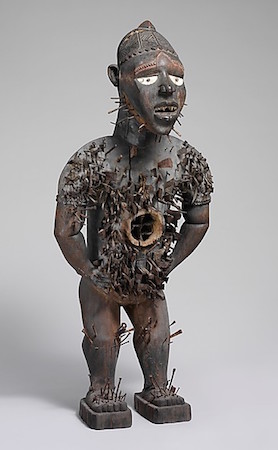Nkisi Nkondi
 |
| Power Figure (Nkisi N’Kondi: Mangaaka), mid to late nineteenth century, wood, paint, metal, resin, ceramic, 46 7/16″ / 118 cm high, Democratic Republic of Congo (The Metropolitan Museum of Art) |
The power figure was made in the mid 19th to the 20th century, by the Congo peoples. It was made of wood, pigment, nails, cloth, beads, shells, arrows, leather, nuts, and twine. Nkisi refers to a spirit, but more specifically medicine that is used by a healer to help someone, herbs and supplements. A Nganga is a ritual specialist who use the Nkisi around the 19th century. In the figure there is a space for holding the medicine, which is called a Mooyo, the belly. Mooyo is the spiritual center of the Nkisi figure, where medicine is placed. As the different mixtures of healing potions were made they were placed in the figure and sealed up. The figure was used to heal the client in the way of the help needed. It was also used to record agreements or contracts. It could also be activated to go after evildoers. The nails were hammered into it to call the Nkisi to come and do its bidding of broken agreements of contracts.
 |
| Face (detail), Power Figure (Nkisi N’Kondi: Mangaaka), mid to late nineteenth century, wood, paint, metal, resin, ceramic, 46 7/16″ / 118 cm high, Democratic Republic of Congo (The Metropolitan Museum of Art) |
The Power Figure is controlled by the Nganga which is the only person to use the Nkisi. The Nganga is a ritual specialist. He would create the medicine to help heal the person in need. As the medicine was placed in the Mooyo, the belly. Then, a nail was beat into the back to be summoned or a bell was rung.
The roles of the materials were all different. First, there were amulets, beaded or a nut, carved into. Also, seed pods, pieces of animals, carved figures with something in their bellies. There is also two crocodiles interlocking. The bell just like the nails, can be fun to bring the Nkisi spirit to the figure. It originally had legs and was able to stand, but without the medicine it was crumbling and crusting without it.
It changed throughout Time because it begins to crust and crumble, almost as if it were growing old without the medicine to bring it to life. The form someone stays the same, but the materials begin to decay after some time.
Citations:
- David C. Driskell, Michael D. Harris, Wyatt Macgaffey, and Sylvia H. Williams, Astonishment and power (Washington: Published for the National Museum of African Art by the Smithsonian Institution Press, 1993).
- Robert Farris Thompson, Flash of the spirit: African and Afro-American art and philosophy (New York: Random House, 1983).
Well done Chloe, I think you did a great job, much better than myself on this topic. I think you added a comfortable bout of details and explanation that really helped visualized what the statues are used for and by whom. Thank you for this, I think the only thing that is really pressing about this is... well, nothing. I could not find anything wrong with this post!
ReplyDelete